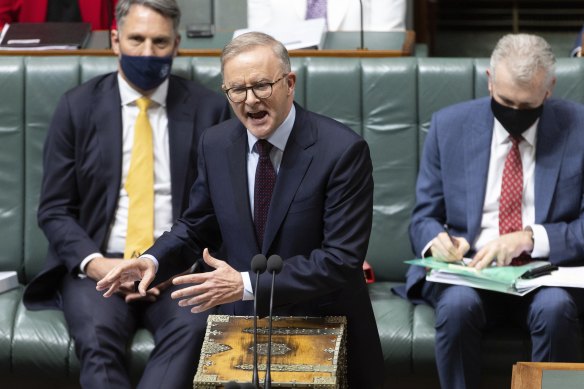Success for the federal government’s 2030 climate goal hinges on two ambitious schemes to force big businesses to cut their carbon pollution, and the deadline looms large with just 89 months to go.
Here’s how it will work.
Prime Minister Anthony Albanese endorsing the government’s Climate Change Bill in the lower house on Thursday. Credit:Alex Ellinghausen
One of the government’s two key emissions policies is to ratchet up caps on pollution under the safeguard mechanism, which would force 215 of the nation’s biggest polluters to cut their greenhouse gas emissions. Crucially, the Labor government has not detailed what those caps would be.
Its other key policy is to boost the proportion of renewable energy in the electricity grid from 30 per cent to 82 per cent by the end of the decade.
Labor’s climate policy goal, to cut emissions 43 per cent below 2005 levels by 2030, is set to become legally binding after the federal government’s Climate Change Bill was approved by the lower house and the Greens committed to back it in the Senate. The long-term goal is to reach net zero by 2050, but it’s an open question if Labor can achieve its reforms without extra costs to businesses and consumers.
Labor’s plan to switch the grid to renewables would increase the availability of clean power so companies could switch over from fossil fuels. For example, a food processor could swap gas boilers for electric heat pumps.
However, the energy market has estimated that transforming the electricity grid will require $300 billion of investment in clean energy generation and infrastructure by 2050.
The government has pledged $20 billion in cheap loans to transmission companies, at a lower cost than private finance, to reduce the cost of network expansion. But that’s only a small piece of the puzzle.
Private investors will have to stump up hundreds of billions of dollars and those costs will ultimately be recouped from consumers.
Even if the government manages to replace coal power with cheaper renewable generation without extra costs to consumers, manufacturing costs could still be driven up by the safeguard mechanism.
Each of the 215 companies captured under the mechanism create more than 100,000 tonnes of greenhouse gases a year, generating a total of 140 million tonnes of greenhouse gases. That’s 28 per cent of Australia’s annual emissions of 501.5 million tonnes.
Under Labor’s plan to tighten pollution caps, these companies have a range of options to cut their emissions, including using clean technology, emissions offsets or emissions capture. For example, an aluminium smelter could use technology to replace its gas-fired furnaces with renewable energy. A coal mine could capture the greenhouse emissions that are typically released into the atmosphere when a coal seam is tapped.
The other option is for a company to buy carbon credits, which are currently trading at more than $30 a tonne, to offset emissions.
Labor promised during the May election campaign there would be exemptions for trade-exposed industries that compete with international companies operating from jurisdictions that don’t impose emissions caps.
Consultation on the details of the safeguard mechanism is set to start as soon as this month, and it’s more than likely that many companies will ask the government for easier emissions reduction targets than their competitors.
Cut through the noise of federal politics with news, views and expert analysis from Jacqueline Maley. Subscribers can sign up to our weekly Inside Politics newsletter here.
Most Viewed in Politics
From our partners
Source: Read Full Article

